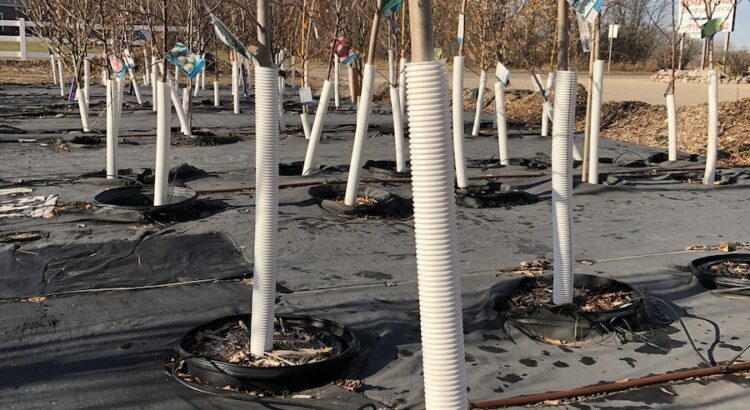Protecting Trees and Shrubs in the Winter

Winter sun, wind, and cold temperatures can bleach and desiccate evergreen foliage, damage bark, and injure or kill branches, flower buds, and roots.
Plants that are hardy in Zone 4 and 5 may be injured if winter conditions are abnormally severe or if plants have been stressed by the environment. Injury is more prevalent and more severe when low temperatures occur in early fall or late spring when there is little or no snow cover. Fluctuations in temperature can be extremely detrimental to plants throughout the fall, winter, or spring.
Sun-scald is characterized by elongated, sunken, dried, or cracked areas of dead bark, usually on the south or southwest side of a tree. On cold winter days, the sun can heat up bark to the point where the cambial activity is stimulated. When the sun is blocked by a cloud, hill, or building, bark temperature drops rapidly, killing the active tissue, causing the tree to crack.
Young trees, newly planted trees, and thin-barked trees (cherry, crabapple, honey locust, linden, maple, mountain ash, and plum) are most susceptible to sun-scald. Trees that have been pruned to raise the lower branches, or transplanted from a shady to a sunny location are also sensitive because the lower trunk is no longer shaded. Older trees are less subject to sun-scald because the thicker bark can insulate dormant tissue from the sun’s heat ensuring the tissue will remain dormant and cold hardy.
Sun-scald can be prevented by wrapping the trunk with a commercial tree wrap, plastic tree guards, or any other light-colored material. The wrap will reflect the sun and keep the bark at a more constant temperature. Put the wrap on in the fall and remove it in the spring after the last frost. Newly planted trees should be wrapped for at least two winters and thin-barked species up to five winters or more.
Evergreens

Whether it’s a newly planted evergreen or one that’s several years old, preparation and protection are very important. Browning or bleaching of evergreen foliage during winter occurs for fours reasons:
- Winter sun and wind cause excessive foliage water loss, while the roots are in frozen soil and unable to replace lost water. This results in desiccation and browning of the plant tissue.
- Bright sunny days during the winter cause warming of the tissue which in turn initiates cellular activity. Then, when the sun is quickly shaded, foliage temperature drops and is injured or killed.
- During bright, cold winter days, chlorophyll in the foliage is destroyed. This results in a bleaching of the foliage.
- Cold temperatures early in the fall before plants have hardened off completely or late spring after new growth has occurred can result in injury or death.
Foliage damage normally occurs on the south, southwest, and windward sides of the plant, but in severe cases, the whole plant may be affected. Yew, Arborvitae, Alberta Spruce, and Hemlock are most susceptible, but winter browning can affect all evergreens. New transplants or plants with succulent, late-season growth are particularly sensitive.
There are ways to minimize winter injury to evergreens including properly place your evergreens in the landscape. Areas in full sun in highly exposed areas are to be avoided. Protecting them from the elements, purchase winter protection bags or construct a barrier of burlap on the south, southwest, and windward sides. As well as keeping evergreens properly watered throughout the growing season and into the fall. Decrease watering slightly in September to encourage hardening off, then water thoroughly in October until freeze-up. Watering only in late fall does not help reduce injury.
For more information visit:




